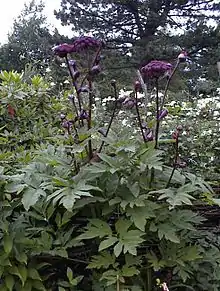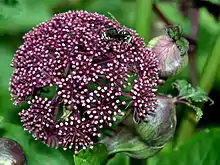Angelica gigas
Angelica gigas, also called Korean angelica,[1] giant angelica, purple parsnip, and dangquai, is a monocarpic biennial or short lived perennial plant from China, Japan and Korea. It inhabits forests, grasslands and banks of streams. The roots are used in traditional Chinese medicine.
| Angelica gigas | |
|---|---|
 | |
| Scientific classification | |
| Kingdom: | Plantae |
| Clade: | Tracheophytes |
| Clade: | Angiosperms |
| Clade: | Eudicots |
| Clade: | Asterids |
| Order: | Apiales |
| Family: | Apiaceae |
| Genus: | Angelica |
| Species: | A. gigas |
| Binomial name | |
| Angelica gigas Nakai | |
Description
Angelica gigas is a stout plant that is 1 to 2 meters high with deep thick roots and purplish ribbed stem. Its leaf blades have a triangular-ovate outline. Korean Angelica has a 20–40 × 20–30 cm, 2–3-ternate-pinnate arrangement. The plant's purple umbel measures 5–8 cm across. Its dark purple-red obovate flowers, blooms in late summer.
Cultivation
Giant angelica prefers moist soil and full sun or semishade. The plant is best propagated through seeds in the spring. The plant is a biennial that flowers in the months of July to August.[2]
Plants produce seeds abundantly; being a biennial (blooming second year and producing only foliage first) you will need to be careful to identify seedlings the first year, they are fairly small and can easily be overlooked if you are not aware of where they have germinated. Easily transplanted first or second year of growth.

Chemical components
Research in 2007 has isolated a chemical from the root of the plant, a coumarin derivative called decursin, that may have anti-androgenic properties in vitro.[3] In 2013, the main substance decursin, decursinol angelate (its isomer), JH714 (the ether form) and epoxide decursin (the epoxide form) were analyzed in vitro and in vivo. CYP isoforms were inhibited more than 50%. There was good blood brain barrier permeability in rats after oral administration of all but epoxide. Pharmacokinetic studies after oral and intravenous administration of 10 mg/kg showed that after 8 hours all test compounds stayed in the gastrointestinal tract at more than 1.5% of the dose and less than 0.5% was excreted in urine.[4]
References
- English Names for Korean Native Plants (PDF). Pocheon: Korea National Arboretum. 2015. p. 354. ISBN 978-89-97450-98-5. Archived from the original (PDF) on 25 May 2017. Retrieved 24 December 2016 – via Korea Forest Service.
- "Angelica gigas - Nakai". Plants for a Future. Retrieved 4 October 2011.
- Lu, J; Kim, SH; Jiang, C; Lee, H; Guo, J (2007). "Oriental herbs as a source of novel anti-androgen and prostate cancer chemopreventive agents". Acta Pharmacologica Sinica. 28 (9): 1365–72. doi:10.1111/j.1745-7254.2007.00683.x. PMID 17723170.
- Mahat, B; Chae, JW; Baek, IH; Song, GY; Song, JS; Ma, JY; Kwon, KI (Oct 2013). "Biopharmaceutical characterization of decursin and their derivatives for drug discovery". Drug Dev Ind Pharm. 39 (10): 1523–30. doi:10.3109/03639045.2012.717296. PMID 23003006.
